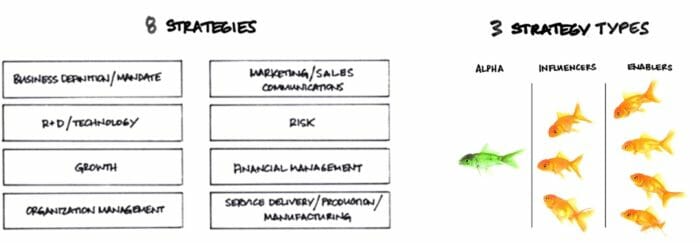At first, dynamic strategic planning sounds like an oxymoron; like “lead balloon” or “genuine imitation”. How could strategic planning become dynamic?
The answer is simple but elegant. There is a dynamic strategy system to be found in every organization.
This is the premise in Alan Kennedy’s book, The Alpha Strategies: Understanding Strategy, Risk, and Values in Any Organization, which offers a convincingly researched explanation that there are eight strategies common to every for-profit, non-profit and public sector organization. The eight strategies are organized into three types, forming a dynamic system that is unique to each organization. One strategy is the Alpha or dominant strategy while three are Influencers because they most guide and constrain implementation of the Alpha and the four remaining strategies, called Enablers.
 Further evidence of a dynamic system in every organization is that a “Chief” can be found today for each one of the eight. There are Chief Financial Officers, Chief Risk Officers, Chief Marketing Officers, Chief People Officers, Chief Production Officers, Chief Technology Officers, Chief Growth Officers, and so on. The eight strategies can be seen as the foundation of all organization design.
Further evidence of a dynamic system in every organization is that a “Chief” can be found today for each one of the eight. There are Chief Financial Officers, Chief Risk Officers, Chief Marketing Officers, Chief People Officers, Chief Production Officers, Chief Technology Officers, Chief Growth Officers, and so on. The eight strategies can be seen as the foundation of all organization design.
The Alpha for any organization is identified by thoughtful research. For example, banks have Financial Management as the Alpha. Insurers have Risk, as do the military, regulators, and law enforcement. “Tech” companies typically have R&D/Technology while car companies have Manufacturing and retailers have Marketing/Sales. The Alpha strategy is the one strategy that most characterizes the organization and its culture.
The Influencers are the three strategies that most guide or constrain the implementation of the Alpha. For example, banks have Risk as an Influencer guiding and constraining implementation of the Financial Management Alpha. Insurers have Financial Management as one of the Influencers. The remaining strategies become the Enablers.
The real benefit of the approach is enabling the ability to map the eight strategies. This creates a powerful visual and a much deeper understanding of the organization. Once there is consensus on the map, there can be a discussion on how a changing external reality and stakeholder expectations might affect the map.
Another benefit is the elimination of confusing planning terminology such as vision, mission, goals, objectives and so on. Instead, the focus is on eight choices of action.
The model tells us why the strategic plan does not need to be written down for many organizations. There is a dynamic system in place that is already up and running and the management team intuitively understands it very well. But the day will come when intuition no longer works. At that point, the team can turn to Dynamic Strategic Planning.
*
 Alan Kennedy, BA LLB FCMC, is the creator and facilitator for Dynamic Strategic and Business Planning and a highly experienced strategy consultant who has been teaching for Schulich ExecEd since 1992. A lawyer by training, Alan is a Fellow and Honor Roll Member of the Canadian Association of Management Consultants.
Alan Kennedy, BA LLB FCMC, is the creator and facilitator for Dynamic Strategic and Business Planning and a highly experienced strategy consultant who has been teaching for Schulich ExecEd since 1992. A lawyer by training, Alan is a Fellow and Honor Roll Member of the Canadian Association of Management Consultants.














